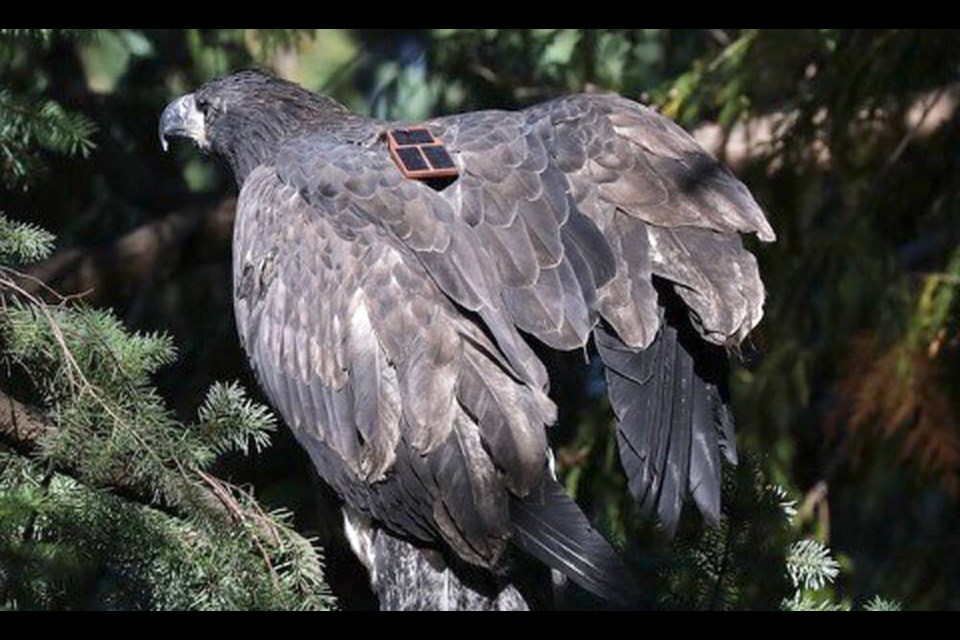Think of it as a bird’s-eye view of a bird’s-eye view.
There are now three North Shore eagles , allowing us to keep an eye on their movements in almost real time.
The Hancock Wildlife Foundation, with some help from the North Shore Eagle Network and Orphaned Wildlife Rehabilitation Society, recently released Bee, an eaglet who fell from his Lighthouse Park area nest when he was about eight weeks old.
Volunteers spotted him and arranged for OWL to come pick him up. They nursed the starving eaglet back to health, but the Hancock Wildlife Foundation also saw the opportunity to put him in a backpack-like harness with a solar panel and transmitter that automatically uploads GPS data whenever it is in range of a cell tower.
Bee’s mother Annie, who is part of a lineage of eagles nesting around Lighthouse Park since then 1960s when there were only three nests remaining in the Lower Mainland, was the first North Shore eagle to have one.
When Bee was released back in his home territory this month, about a dozen volunteers and supporters from the Eagle Network gathered to watch, said Sally McDermott, North Shore Eagle Network co-ordinator. Bee had a rough landing in the branches at first and kept mostly still after. After about 30 minutes, he called out and both his mother and father called back. But the conversation was brief and Annie soon after flew out over Howe Sound. A few hours later, her tracker indicated she was north of Powell River, having started her annual northern migration, where all of the Lower Mainland’s eagles go to feed on the carcasses of spawning salmon.
Later in the fall, she’ll return and the northern populations of eagles will sojourn south soon after to Metro Vancouver to feed and scavenge here.
Data from the trackers on eagles like Annie and Bee is now showing scientists, in greater detail than previously conceived possible, what the eagles are doing once they are out of eyeshot, McDermott said.
In time, the Hancock Wildlife Foundation will share a real time map showing Bee’s movements, with trackers.
Biologists and advocates are now eager to see what they can learn with two closely related eagles both wearing trackers.
In the past, eagle watchers have seen highly territorial, established eagle pairs tolerating juvenile outsiders on their turf (or even in their nests). Eagle expert David Hancock said they’ve speculated that the newcomers may be the offspring coming home for a visit, but the data now coming in from trackers on other juvenile birds shows that, so far, not one has returned to the area where they hatched.
Hancock joked that the birds clearly hadn’t been listening to his lectures on the subject.
“What we do know is so small compared to what we want to know,” Hancock said. “We’re learning so much every day from these things.”
The one other eagle on the North Shore with a tracker is Harbour Sun, a female from the territory immediately north of Annie’s, around the appropriately named Eagle Harbour. McDermott said it has been fascinating to look over the maps of where Annie and Harbour Sun have travelled both to hunt and rest, while keeping their beaks out of each other’s business.
“Neither of them has gone into each other’s territory. There is absolute respect for each other’s territory,” she said.
Bald eagle population rebounding
The species has come back from near extinction in the 1960s to a flourishing 600 known mated pairs in the Lower Mainland, but an outbreak of avian influenza in 2021, Hancock said.
Following the outbreak and some extreme weather events in 2021, in 2022, which was a bleak sign, McDermott said. This year, however, 17 known chicks have lived to make their first northern migration.
“So, 17 out of 22 is not that great, but a heck of a lot better than when we had the five out of 22 last year,” McDermott said. “We’re just hoping that this year is such an improvement over last year that we're going in the right direction.”
Eagles face persistent threats from habitat loss, pesticides, microplastics, loss of prey and food to scavenge, and, of course, climate change, Hancock said. For now, though, he’s encouraged by 2023’s successful fledges.
“The fact that they bounced back as they did this year is kind of awesome. Nests in most of the areas in the Lower Mainland have produced more than one chick per nest. That’s more than they would produce in the wilderness,” he said. “They’re going to work at building back the population. That’s encouraging. That says that the basic habitat that we have here is pretty good. We just have to keep looking after it.”
If you find a dead chick or eagle, don’t touch it with your bare hands. Instead, report it to the province, which is monitoring for signs of avian flu, at 1-866-431-BIRD (2473).
The North Shore Eagle Network, meanwhile, is always looking for volunteers who can help keep an eye on the local eagle population.
Video: from on .




